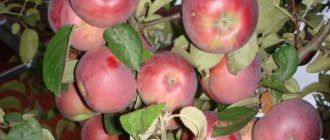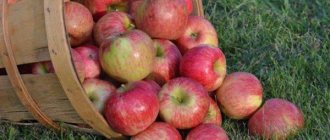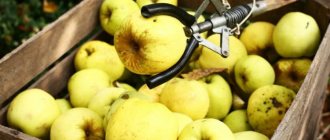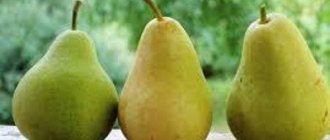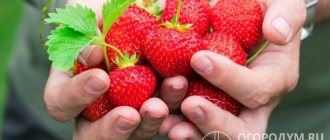Subspecies
Candy summer
This is not a variety, this is a marketing and advertising gimmick. Since “Candy”, in terms of ripening period, is an early summer species and is sometimes ready for harvesting already in the first week of August.
Ranet Candy
Ranet candy apple tree - we simply cannot give a description of the variety, since this is a trick of traders . in normal apple tree pomology .
Candy-2
The more modern apple tree Konfetnoe-2 is a clone of the original variety with improved characteristics . It has higher transportability and the crown is more convenient in terms of size.
Fruits of the apple tree Candy-2.
How to choose seedlings?
Growth, development and abundance of fruiting depend on the choice of high-quality planting material. It is best to purchase one- or two-year-old seedlings for planting. You should buy them only in specialized stores or well-established nurseries.
Find out how to choose the right quality apple tree seedling.
When purchasing planting material, it is necessary to carefully inspect and discard those that have the following defects:
- damage to bark and roots;
- spots and growths on the root collar;
- brittle and rotten rhizome.
The seedling must be healthy in appearance, with a strong, well-developed rhizome, no higher than 2.5 m in height. The stem of high-quality planting material under the bark should be colored light green.
Care
Caring for a Candy apple tree is to:
- To feed when she is hungry;
- Watered when there was drought;
- Treated if she got sick;
- Driven away parasites.
Therefore, it is important to properly and timely care for the tree:
- Immediately after planting, frequent, abundant watering is needed;
- When the tree begins to “grow its crown”, it must be properly cleaned;
- Particular attention must be paid to the introduction of microelement fertilizers. Local fertilizers such as stove ash and humus are considered very necessary for apple trees. Organic fertilizers are applied around the trunk and only once a year.
Advice! It is necessary to loosen the soil regularly if you do not use grass in the garden.
To protect the apple tree from scab, during the period of opening of the bud scales, the apple tree should be sprayed with Fluazinam.
Also in the fall, the roots of the apple tree are mulched , and in the winter, snow is packed onto the trunk . This way the tree will produce a larger harvest and will be easier to harvest.
Disease and pest control
Reviews from gardeners confirm that the popular Candy apple tree variety is relatively resistant to most diseases and pests, except for scab. In early spring, during the period of dormant buds, preventive spraying is carried out with Bordeaux mixture or copper oxychloride. They have an antifungal effect.
At the first signs of the disease, 2-3 treatments are carried out (depending on the instructions for the drug) with systemic fungicides: Skor, Raek, Horus, Strobi. Supporters of organic farming use herbal medicines: Fitosporin, Gamair, Fitolavin.
Common pests, the fight against which begins at the first sign of detection, are leaf-eating and leaf-sucking: aphids, copperheads, various scale insects, mites - they are destroyed by pyrethroids. For preventive purposes, autumn spraying with the drug Oleocuprin is carried out.
On different rootstocks
In addition to Kitayok and Ranetok, the variety usually takes root on any rootstock , generally suitable for all summer apple trees.
Dwarf
When grown on a dwarf rootstock, the height of the apple tree does not exceed 1.7 m , and fruiting begins in the second year.
From a five-year-old apple tree, up to a quarter of a hundredweight is harvested. The weight of the fruit reaches 200 grams.
Young apple trees bear fruit constantly, but without fertilizing the fruits decrease in size.
Semi-dwarf
Candy growing on a semi-dwarf rootstock is, of course, possible, but only in the southern regions . Because in the northern regions it sometimes freezes slightly.
Columnar
Unfortunately, today this is a deception of traders . Columnar apple trees with this name have not been registered.
Description of the variety
The Caramel apple tree is quite tall, productive, and frost-resistant.
Wood appearance
The Candy tree is tall; in the first 3 years of its life it can grow up to 3 meters. Then the growth rate slows down slightly, and as a result, the height of an adult tree does not exceed 5 meters.
Modern gardeners, wanting to speed up the start of fruiting of a young apple tree, graft seedlings onto dwarf rootstocks. Then the tree begins to bear fruit 2-3 years after planting, its height will not exceed 1.8 meters.
Attention! You can resort to a compromise and plant Caramel in the garden, grafted onto a semi-dwarf rootstock. Then the height of the tree will be 3 meters, it will begin to bear fruit 3 years after planting.
An adult Candy tree has a spreading crown. The branches are well leafy, the color of the leaf blades is rich green, the leaf size is above average.
Taste qualities of apples
Candy is classified as a summer variety with a ripening period that occurs simultaneously with such varieties as:
- Chinese;
- White filling;
- Melba.
The fruits are slightly flattened in shape when green, becoming rounded as they ripen. The size of the fruit varies in the range of 80-120 g, in some cases, with good moisture supply and a high agricultural background, their weight can reach 180-190 g. Having reached technical ripeness, the fruits have a yellow-green color. Then, under the influence of sunlight, red streaks appear on the apples.
The pulp of the fruit is tender and has a pleasant taste. The variety is in great demand on the market.
Important! A large amount of iron and vitamin C was found in the fruits of Candy, they are very useful for the children's body.
Self-fertility, pollinators
Caramel is partly a self-pollinating plant. If you plant other varieties of apple trees blooming nearby at the same time, the apple yield will certainly increase.
The best pollinator varieties for Candy:
- Melba;
- Padding;
- Yandykovskoe;
- Belevoye;
- Red early.
Advice! Since pollen from one flower to another is carried by insects, it is advisable to place at least one hive of bees in the garden. This will affect the increase in apple yield.
Winter hardiness, frost resistance, drought resistance
The big advantage of Caramel is its frost resistance. In winter, the tree can withstand air temperatures dropping to minus 28 degrees. Taking into account the fact that even after a very harsh winter the tree always recovers again, gives growth and forms a harvest, we can note the high degree of winter hardiness of this variety.
Resistance to drought and other unfavorable environmental factors inherent in the summer period is at the level of average values.
Beginning of fruiting
A young Caramel tree begins to bear fruit in different ways depending on the rootstock on which the tree grows:
- on ordinary rootstocks, the apple tree will begin to bear fruit at the age of 5 years;
- seedlings grafted onto dwarf rootstocks will produce a harvest in the second year from the moment of planting.
Productivity, timing of ripening, flowering
The Candy variety enters the flowering phase in May; small, white-pink flowers appear. Caramel is one of the earliest summer varieties; apples can begin to be picked at the turn of July and August.
The productivity of the variety is impressive. Five-year-old apple trees can produce up to 50 kg of fruit per season. Mature apple trees produce more than 100 kg of apples annually.
Advantages and disadvantages
A description of a variety would be incomplete without indicating its pros and cons.
| Advantages | Flaws |
|
|
Important! Since Caramel fruits are very sugary, they are strongly affected by wasps in the phase of full ripeness.
Resistance to diseases and pests
Candy has sufficient resistance to common pests and diseases, with the exception of wasps and scab.
Scab in a rainy summer can greatly reduce the productivity of the Candy Plant. In such seasons, it is necessary to carry out preventive spraying of the tree crown with preparations containing copper.
Landing dates
Planting a seedling in the ground is possible both in early spring and late autumn, but so that after planting in the fall the seedling does not begin to grow (that is, after the leaves fall).
Planting a Candy apple tree is possible both in spring and autumn.
Spring
Planting holes for spring planting must be prepared in advance , well flavored with organic matter . Also in spring, seedlings are watered thoroughly, the more and more often, the better.
Rules for growing an apple tree
How to choose seedlings?
It is better to do this in nurseries. Choose healthy seedlings, no older than 2 years. The roots must be developed, the central one at least 30 cm long. They need to be sprayed with water before transportation.
It is advisable to immerse the seedlings in water before planting if the roots have dried out.
Landing dates
The Candy apple variety is recommended to be planted in the ground in the fall, in early September. But you can do this in the spring, from mid-April. In the first case, the plant has time to take root by winter. During the second summer it will get stronger and take root better.
Feeding and watering
After planting, for the first two months, you need to water every week if there is no rain. Then reduce them to once every 2-3 weeks. In hot weather, it is recommended to water by sprinkling in the evening to avoid burning the leaves. Organic and mineral fertilizers are used for feeding.
Apply fertilizers in the following order:
- In April, after planting, use 0.5 kg of urea. You can use ash, 3-5 cups per square meter.
- In the 2nd half of May, at the time of flowering, feed with a mixture of fertilizers. To do this, for 7 days you need to infuse 100 g of superphosphate, 80 g of potassium sulfate and 20 g of urea in 20 liters of water.
- When fruiting, use a solution of 100 g of nitrophoska, 2 g of sodium humate, diluted in 20 liters of water.
- After harvesting, add a mixture of humus, 0.3 kg of potassium sulfate, 0.3 kg of superphosphate.
Trimming
When planting, you need to trim the top of the seedling to form a crown. Then pruning is carried out in the spring before the apple tree blooms and in the fall after harvesting. Remove damaged, improperly growing branches, i.e. those that grow inward or at an acute angle. Be sure to prune old trees, this will increase the yield of apple trees.
Preparing for winter
Before frost sets in, cover the tree trunk with leaves or peat. Cover the roots with spruce branches. After the snow falls, shovel it towards the trunk and compact it so that the soil and roots do not freeze. To protect the trunk, the first 5 years require whitewashing with chalk, then with lime. Use a mixture of 3 kg of slaked lime, 500 g of copper sulfate and 10 liters of water.
Crown formation
The configuration of the Candy tree is very dependent on the rootstock. The variety can be grown on a frost-resistant skeleton-forming plant, or in the form of a stanza. These apple trees have excellent restorative ability. Therefore, mistakes in crown formation are “forgiven” to inexperienced gardeners.
Carefully! The use of newfangled types of crown formation must be used carefully, otherwise the tree may die!
Features of planting and care in different regions
Moscow region
"Candy" requires good sunlight in the northern growing zone. In a shaded area, the tree will feel bad; it will not be able to grow normally and form a crown.
Ural
Apple trees in the Urals need rich and non-sinking soil . The soil must also retain moisture and nutrition. It would be good if there was no groundwater close to the surface and the soil was not acidic.
Primorye
The hole for planting work in Primorye is dug six months in advance and during planting the following must be added:
- Humus compost;
- Saltpeter;
- Superphosphate;
- Nitroammophoska.
The tree requires an elevation or can be surrounded by a drainage ditchif the precipitation is too high.
The planting pit in Primorye is prepared in advance.
Siberia
The variety can be grown in Siberia. But care must be taken to protect the young bark on the branches and trunk using burlap. You also need micronutrient supplements and a lot of humus.
North-West Russia
An area with fertile soil is best suited for planting. The soil must be well provided with fertilizing, especially before sustainable fruiting. You also need to add a lot of organic mulch and substances that deoxidize the soil. But the variety is relatively unpretentious for the Non-Black Earth Region .
Reviews from gardeners
Tuleytsev. Krasnoyarsk “I live in Krasnoyarsk, with a cold climate and low winter temperatures. There are several “Candy” apple trees growing on my own summer cottage, which I really liked for their unsurpassed aroma and taste. I harvest at the end of July or at the beginning of August. I usually collect up to 60 kilograms from an apple tree. Before the cold weather, I certainly surround the trunk with leaves, straw, and low-lying peat in order to preserve the tree for next summer. Apples must be stored cool; they can be stored in the refrigerator for up to 70 days, but they won’t all fit. I keep it in the cellar, where it stays in the hay dust for no more than 60 days. Therefore, they need to be processed into preserves, jams, and compotes. But transporting these apples over long distances is almost impossible.”
Kabotoreev. Bryansk. “The Candy Apple tree has been growing at our dacha for several years. Already in the third year of her life, beautiful apples appeared on her. In fact, their taste was unique and extremely sweet. The tree grows quickly. It is undemanding, the leaves do not curl from worms and aphids, like on other apple trees. How nice it is to enjoy “candy” apples in the summer heat after long cold weather. Due to their significant pectin content, these apples are suitable for jelly, jam, marmalade and marmalade.”
Zortsev. Minsk “The most delicious of the “summer apple trees” are “Konfetnoye” and “Melba” (they ripen by the end of August). And my opinion is this: the variety is ideal for pies and compotes. I don’t like sweet varieties, but these apples are like candy - very tasty! It's a pity, they don't last long. This apple must be eaten from the tree, then all its rich taste is felt, and after resting, “Candy” becomes like cotton wool or a “potato” consistency.”
Harvest
On average, it will be possible to get a harvest from this variety only in the 4th year of its life. The rootstock plays a major role in fruiting. For example, on a low-growing basis, it can begin to bear fruit already in the 2nd year of its life. Starting from 5 years, the tree consistently produces 30-50 kg of fruit. At 10 years old she can produce 100 kg per tree.
It stands on a very strong stalk. Even after ripening, the apples do not fall off, but remain on it. This is a plus, especially for industrial purposes, where crumbling apple trees are absolutely not valued.
